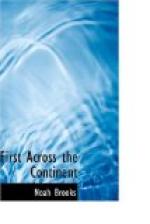Arriving at the village, the ceremony of smoking the pipe of peace was solemnly observed; and the women and children of the tribe were permitted to gaze with wonder on the first white men they had ever seen. The Indians were not much better provided with food than were their half-famished visitors. But some cakes made of service-berries and choke-berries dried in the sun were presented to the white men “on which,” says Captain Lewis, “we made a hearty meal.” Later in the day, however, an Indian invited Captain Lewis into his wigwam and treated him to a small morsel of boiled antelope and a piece of fresh salmon roasted. This was the first salmon he had seen, and the captain was now assured that he was on the headwaters of the Columbia. This stream was what is now known as the Lemhi River. The water was clear and limpid, flowing down a bed of gravel; its general direction was a little north of west. The journal says:—
“The chief informed him that this stream discharged, at the distance of half a day’s march, into another (Salmon River) of twice its size, coming from the southwest; but added, on further inquiry, that there was scarcely more timber below the junction of those rivers than in this neighborhood, and that the river was rocky, rapid, and so closely confined between high mountains that it was impossible to pass down it either by land or water to the great lake (Pacific Ocean), where, as he had understood, the white men lived.
“This information was far from being satisfactory, for there was no timber here that would answer the purpose of building canoes,—indeed not more than just sufficient for fuel; and even that consisted of the narrow-leaved cottonwood, the red and the narrow-leaved willow, chokecherry, service-berry, and a few currant bushes, such as are common on the Missouri. The prospect of going on by land is more pleasant, for there are great numbers of horses feeding in every direction round the camp, which will enable us to transport our stores, if necessary, over the mountains.”
While Captain Lewis was thus engaged, his companions in the canoes were slowly and laboriously ascending the river on the other side of the divide. The character of the stream was much as it had been for several days, and the men were in the water three-fourths of the time, dragging the boats over the shoals. They had but little success in killing game, but caught, as they had done for some days before, numbers of fine trout.
“August 14. In order to give time for the boats to reach the forks of Jefferson River,” proceeds the narrative, “Captain Lewis determined to remain where he was, and obtain all the information he could collect in regard to the country. Having nothing to eat but a little flour and parched meal, with the berries of the Indians, he sent out Drewyer and Shields, who borrowed horses from the natives, to hunt for a few hours. About the same time the young warriors set out for the same purpose.




